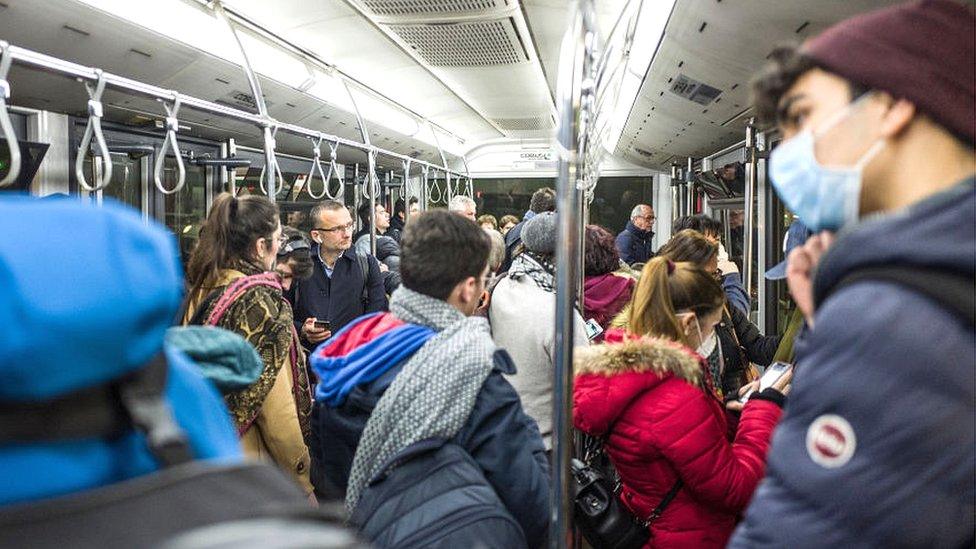Coronavirus: What's the risk of Covid on public transport?
- Published

The number of people using public transport is far lower than before the pandemic, but it's rising steadily.
What are the risks of catching Covid for those who need to travel?
How safe are trains and buses?
A lot depends on how crowded a bus or train is, and how much distance you can keep from other people.
Scientists recognised these potential dangers, external early in the pandemic.
Dr Julian Tang, a clinical virologist at the University of Leicester, says a key concern is sharing enclosed airspace, because coronavirus particles linger in the air.
"If you're close enough to smell someone's garlic breath on public transport," he says, "then you're also potentially inhaling any virus that's carried with it."
What can I do to protect myself?
Wearing a mask can lessen the risk, as can keeping windows open to encourage air flow.
The chance of picking up the virus from contaminated surfaces is now believed to be far lower than previously thought.
The main US health agency, the Centers for Disease Control (CDC), says the chance of catching Covid via contaminated surfaces is less than one in 10,000, external.
A study by Imperial College London for Transport for London in February tested samples from escalators, buttons and handles and found no traces of the virus, external.
What safety measures are operators taking?
As numbers increase, rail companies are increasing capacity, to enable social distancing and prevent packed trains.
The Rail Delivery Group says more than 1,000 weekday services have been added since mid-February, with more planned in May.
There will also be longer trains, to make it easier for people to socially distance.
As well as more hand sanitiser at stations, there will be enhanced train-cleaning too.

Transport for London says trains, trams, buses and stations on its network will continue to be treated with hospital-grade cleaning substances that kill viruses and bacteria.
It also says capacity limits will remain in place on all buses, with the exception of dedicated school services.
What is the risk on planes?
The biggest Covid risk for people travelling by plane is where they go and what they do either side of the journey.
The risk on a plane is relatively low because of how often the air inside the cabin is circulated.
Most planes have something called a high-efficiency particulate air filter (Hepa). This can capture smaller particles than ordinary air-conditioning systems, including some viruses.
It mixes fresh air from outside the plane with air already in the cabin.
"Planes are probably the safest environments on the planet because they have this massive air change rate of 20-30 air changes per hour," said Dr Tang.
That compares to about two to four air changes per hour in a typical office, and four to six per hour in common areas in hospitals.
But it may be harder to socially distance from others on a plane, so wearing a mask remains important.
Will vaccines make a difference?
More than 37 million people in the UK have now been vaccinated, external.
This is a significant number of people who are less likely to become seriously ill if they catch coronavirus. There's also increasing evidence vaccinated people are less likely to pass the virus on.
However, that still means many people are susceptible, so travellers need to continue following Covid guidelines.
"Some measures should be maintained for a while," says Dr Shengjie Lai, a senior research fellow at the University of Southampton.
"Face coverings and hand sanitiser on public transport and in substantially enclosed public areas of transport hubs are still very important."
Will these measures be in place forever?
It depends on how much risk people want to live with, according to Dr Tang.
"Going forward, people may choose to wear a mask - without any fear or stigma - on public transport, like you've seen in south-east Asia after the Sars outbreak in 2003."

SOCIAL DISTANCING: What are the rules now?
SUPPORT BUBBLES: What are they and who can be in yours?
FACE MASKS: When do I need to wear one?
TESTING: What tests are available?
